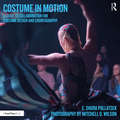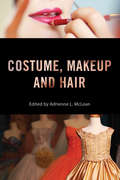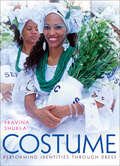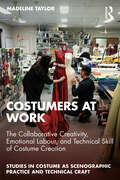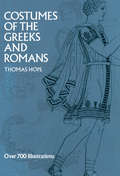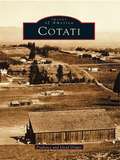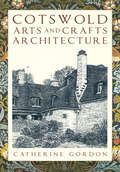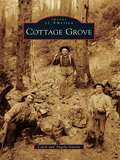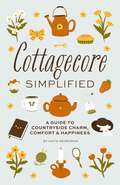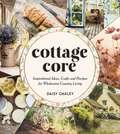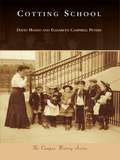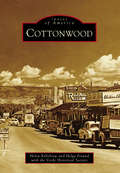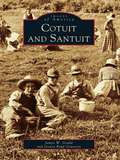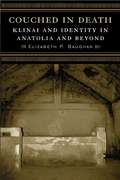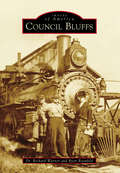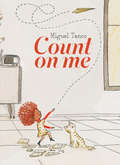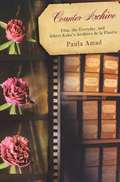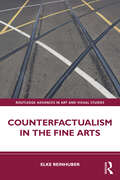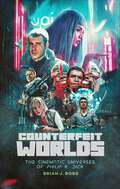- Table View
- List View
Costume in Greek Classic Drama (Dover Pictorial Archive Ser.)
by Iris BrookeAt the peak of its perfection in the fifth century B.C., the glory of classical Greek drama was matched by the magnificence of its costumes. This work describes how performers were dressed in plays by Aeschylus, Sophocles, and Euripides, and explains how the actors' performances influenced the cut of their costumes. 53 black-and-white illustrations.
Costume in Motion: A Guide to Collaboration for Costume Design and Choreography
by Shura PollatsekCostume in Motion is a guide to all stages of the collaboration process between costume designers and choreographers, documenting a wide range of approaches to the creation of a dance piece. Featuring interviews with a diverse selection of over 40 choreographers and designers, in-depth case studies of works by leading dance companies, and stunning original photography, the book explores the particular challenges and creative opportunities of designing for the body in motion. Filled with examples of successful collaborations in contemporary and modern dance, as well as a wide range of other styles, Costume in Motion provides costume designers and choreographers with a greater understanding of the field from the other’s perspective. The book is designed to be part of the curriculum for an undergraduate or graduate level course in costume design or choreography, and it can also be an enriching read for artists at any stage of their careers wishing to hone their collaboration skills in dance.
Costume, Makeup, and Hair
by Robin Blaetz Tamar Jeffers Mcdonald Prudence Black Adrienne L. Mclean Drake Stutesman James Castonguay Karen De Perthuis Mary DesjardinsMovie buffs and film scholars alike often overlook the importance of makeup artists, hair stylists, and costumers. With precious few but notable exceptions, creative workers in these fields have received little public recognition, even when their artistry goes on to inspire worldwide fashion trends. From the acclaimed Behind the Silver Screen series, Costume, Makeup, and Hair charts the development of these three crafts in the American film industry from the 1890s to the present. Each chapter examines a different era in film history, revealing how the arts of cinematic costume, makeup, and hair, have continually adapted to new conditions, making the transitions from stage to screen, from monochrome to color, and from analog to digital. Together, the book's contributors give us a remarkable glimpse into how these crafts foster creative collaboration and improvisation, often fashioning striking looks and ingenious effects out of limited materials. Costume, Makeup, and Hair not only considers these crafts in relation to a wide range of film genres, from sci-fi spectacles to period dramas, but also examines the role they have played in the larger marketplace for fashion and beauty products. Drawing on rare archival materials and lavish color illustrations, this volume provides readers with both a groundbreaking history of film industry labor and an appreciation of cinematic costume, makeup, and hairstyling as distinct art forms.
Costume: Performing Identities Through Dress
by Pravina ShuklaWhat does it mean to people around the world to put on costumes to celebrate their heritage, reenact historic events, assume a role on stage, or participate in Halloween or Carnival? Self-consciously set apart from everyday dress, costume marks the divide between ordinary and extraordinary settings and enables the wearer to project a different self or special identity. Pravina Shukla offers richly detailed case studies from the United States, Brazil, and Sweden to show how individuals use costumes for social communication and to express facets of their personalities.
Costumers at Work: The Collaborative Creativity, Emotional Labour, and Technical Skill of Costume Creation (Studies in Costume as Scenographic Practice and Technical Craft)
by Madeline TaylorCostumers at Work: The Collaborative Creativity, Emotional Labour, and Technical Skill of Costume Creation explores the various forms of work carried out in the costume workshop by the myriads of skilled professionals who transform ideas and sketches into the wearable costumes seen on stage.Costume work, as collective, collaborative, and material labour produced by a predominantly female workforce, has been long overlooked by the performance industry and those who study it. This book exposes the inherent tensions between theatre’s strict hierarchies and collaborative ideology and how these inform the structures negotiated day to day by costumers as they carry out their work. Through close attention to their work, the book establishes costumers’ work as collaborative and complex, a creative and emotional labour that contributes to enhanced storytelling, actor performance, and audience experience. Using extensive ethnographic observation conducted over 14 months at three professional theatre costume workshops around Australia, combined with extant interviews and research from across the globe, Costumers at Work provides explicit theories and guidance about the behaviours, skills, and communication modes that make costume collaboration more effective and enjoyable.This book is written for costume researchers, practitioners, and students of theatrical costume design and construction, along with theatre scholars broadly.
Costumes of the Greeks and Romans (Dover Pictorial Archive Ser.)
by Thomas HopeFrom headdresses to sandals, from warrior's armor to priestess's robes, the authentic costumes of people from all walks of life in the Roman and Greek civilizations are here pictured comprehensively and clearly. Three hundred finely drawn, detailed engravings (containing over 700 illustrations) show just what was worn by the poets, philosophers, priests and priestesses, peasants, Bacchanalians, emperors, generals, Amazons, and virgins of a bygone age.Carefully copied from ancient vases and statuary by Thomas Hope (1770–1831), a British collector and designer, these engravings combine an unusual clarity of style with unquestioned authenticity. Their range, too, is unusually great, for besides the many plates on the costumes of the Greeks and Romans, there are representative illustrations of the typical dress of such other civilizations as the Phrygian, Egyptian, Parthian, Etruscan, and Persian.In addition, scores of engravings are devoted to such now-forgotten objects as ancient musical instruments (the lyre, double flute, pipes of Pan, etc.), Bacchanalian implements, articles of furniture, women's trinkets and jewelry, sarcophagi, altars, and other adjuncts to ancient life.Such comprehensiveness makes this book indispensable to costume designers, stage fitters, and producers of classic plays, students of fashion design, and others interested in ancient costumes. The material included here is covered in no ordinary history, and only here can the interested reader discover just how the draping of the Greek robe was achieved, or what was worn at festivals and funerals by the various classes.Art directors, advertising managers, and others on the lookout for unusual and eye-catching illustrations will also treasure this collection. All of the engravings are royalty free and may be used in any way, whether as striking contrasts to modern styles in dress, jewelry, or furniture; for historical perspective; for mood pieces; or simply as unusual attention-getters.
Cotati (Images of America)
by Lloyd Draper Prudence DraperThe town of Cotati, once the Coast Miwok village of Kot'ati, was by 1850 a 17,000-acre diamond-shaped ranch set in the center of Sonoma County's golden fields. Dr. Thomas Stokes Page and his heirs ran that ranch until the 1890s, when they laid out a town and a distinctive hexagonal plaza with streets named after Dr. Page's sons. That wheel-like plaza earned centrally located Cotati the title, "Hub of Sonoma County." For many years Cotati was the gathering place for hundreds of hardworking chicken ranchers, who bought up small farms in the surrounding countryside, but it was transformed in the 1970s into a hippie haven fed by nearby Sonoma State University. Old chicken houses then became student housing and the Plaza hub that was the setting for traditional community festivals became a vibrating stage for dancing and demonstrations. Cotati's famous downtown nightclub, the Inn of the Beginning, was the proving ground for many now-famous musicians, including John Lee Hooker, Huey Lewis, Vince Guaraldi, Roseanne Cash, and Kate Wolf.
Cotswold Arts and Crafts Architecture
by Catherine GordonBetween 1890 and 1930, Arts and Crafts architecture proliferated within the Cotswolds. The range and quality of the buildings was exceptional, as the region provided the perfect environment for the Movement’s ideals and principles to flourish. Arts and Crafts architects relished the robust vernacular precedent that served to focus their ideas and stimulate their creativity. Its rational basis and dependence on craft skills had lasting relevance, and it was no coincidence that the most infl uential aspect of their work was its emphasis on conservation. The achievements of the Arts and Crafts Movement in the Cotswold region has attracted much interest in recent decades, the appeal of the simple life and traditional values having as much allure now as they did a century ago. This was the first study to focus entirely on the Arts and Crafts architecture within the region, and to examine its impact on the Cotswold landscape, on the survival of the local building traditions and attitudes to heritage and conservation. This new and updated paperback edition provides a guide to the general characteristics of Cotswold Arts and Crafts structures, with chapters on the various types of new commissions to be found, as well as repair and remodeling projects. The final chapter discusses the late flowering of Arts and Crafts work that occurred during the interwar period and beyond, and the legacy of this important body of work at a local and national level.
Cottage Grove
by Angela Garvin Caleb GarvinCottage Grove is a picturesque little hometown nestled in the Willamette Valley. Pioneers following the Oregon Trail west settled in the area in the early 1800s. The Bohemia Mountains were the first major draw to the area after James "Bohemia" Johnson discovered gold in 1863. A gold rush ensued and caused several boom towns to spring up on the route to the mines. After several years, many millions in gold were blasted from the mountains. There is an estimated $14 million in gold remaining in the mountain to this day. With new settlers came the first post offices and schools. When the mining started to slow down, the lumber industry was on the upswing. With easy access to the short line and virgin timber on every hill in the valley, timber became the new boom. Mills sprung up almost overnight, and in some cases burned in a single night. At one time, there were 23 mills on Row River alone.
Cottagecore Simplified: A Guide to Countryside Charm, Comfort and Happiness (Simplified Series)
by Katie MerrimanImagine this: you have a hot cup of tea and a good book in front of you, the aroma of freshly baked bread in the air as sunlight streams in through the window. Daydreaming of a simpler life? Go back to the basics with Cottagecore Simplified.It might not be practical to drop everything and live out your fairytale fantasy, but it&’s easy to embrace countryside comfort while coexisting with the modern world—find inspiration in the crafts, décor, and lifestyle tips in this book. This guide is designed to bring peace and relaxation to your life.Inside you&’ll find:Recipes for baked breads, pies, pastries, and moreEmbroidery, sewing, and quilt patternsIdeas for sketches and doodlesAn introduction to candle and soap makingTips for maintaining your gardenPottery, flowerpressing, and other charming craftsAnd more!Life is all about enjoying the simple things. This idyllic aesthetic allows you to break from monotony and routine. Start off friends and family in their new home with this ideal housewarming gift, or take the plunge yourself into DIY projects and low-waste living. Unplug from the modern world and bring cottagecore to your everyday life with Cottagecore Simplified.
Cottagecore: Inspirational Ideas, Crafts and Recipes for Wholesome Country Living
by Daisy OakleyWelcome to Cottagecore – a world full of wildflower meadows and picnics, homemade jam and floaty dresses, traditional crafts and cosy country retreats. Rekindle your love for nature and find solace in the soothing art of cottagecore with the help of this beautiful book of recipes, crafts, activities and design ideas.
Cotting School (Campus History)
by Elizabeth Campbell Peters David ManzoIn 1893, two pioneering orthopedic surgeons, Dr. Augustus Thorndike and Dr. Edward Bradford, saw the need to educate children whose physical challenges prevented them from attending school. As an experiment, they founded the Industrial School for Crippled and Deformed Children in Boston. Modeled after 19th-century European institutions, the school was America's first for children with physical disabilities. Early classes were held in a church basement where Mary Perry volunteered to teach seven students. Tuition, a hot meal, and transportation in a horse-drawn carriage were free. Thanks to the leadership of the two doctors and board chairman Francis Joy Cotting, within 10 years the school was housed in an impressive, debt-free brick building. Renamed the Cotting School, the school is now located in Lexington and serves 130 day students from 74 communities. Staffed with highly skilled special education teachers; nurses; physical, occupational, and communication therapists; and dental and vision specialists, Cotting is a national leader in serving children with a broad spectrum of learning and communication disabilities, physical challenges, and complex medical conditions.
Cottonwood
by Helga Freund Verde Historical Society Helen KillebrewIn the last quarter of the 19th century, a circle of 16 tall Cottonwood trees stood in the wash that extended to the Verde River just north of where the old jail building now stands. Cattlemen and ranchers from Oak Creek and the mountains made their overnight stops under these trees and the location became known as "The Cottonwoods." The lush riparian area attracted hardy settlers, and Fort Verde's military camp and the copper mines of Jerome provided a ready market for agricultural goods. Thus began the town that was soon to become the commercial hub for the Verde Valley. Today the incorporated city of Cottonwood serves an area population of over 55,000 and boasts a diverse economy based on health care, education, tourism, and the service and retail industries. With its moderate climate, beautiful setting, and small-town charm, combined with the amenities of a larger city, Cottonwood continues to attract steady growth and tourism.
Cotuit and Santuit
by James W. Gould Jessica Rapp GrassettiCotuit, a name derived from a Native American word meaning "place of the council," has a rich history that predates Colonial times and includes continuous Native American habitation. Paired with Santuit on the south shore of Cape Cod and warmed by the Gulf Stream, Cotuit has long been a favorite summer resort and was home to Cape Cod's first hotel. Its greatest attraction has always been the sweet Cotuit oysters, which are shipped to the best shellfish bars in the country.This quiet and unspoiled New England village, once a refuge for pirates, deepwater sailors, and coastal traders, hold secrets that are told only in Cotuit and Santuit. They are home to such people as Henry Adams, whose courtship took place here; the Cape Cod Commandos; a pioneer whistle-blower fighting against environmental pollution; and the witch Hannah Screecham, who guarded Captain Kidd's treasure. Cotuit and Santuit reveals the adventures of the Holy Ghost Festival, the baby brought home from the Pacific whaling grounds in a cask of rum, and the trek over the Arctic Ocean across thirty miles of ice.
Couched in Death
by Elizabeth P. BaughanIn Couched in Death, Elizabeth P. Baughan offers the first comprehensive look at the earliest funeral couches in the ancient Mediterranean world. These sixth- and fifth-century BCE klinai from Asia Minor were inspired by specialty luxury furnishings developed in Archaic Greece for reclining at elite symposia. It was in Anatolia, however--in the dynastic cultures of Lydia and Phrygia and their neighbors--that klinai first gained prominence not as banquet furniture but as burial receptacles. For tombs, wooden couches were replaced by more permanent media cut from bedrock, carved from marble or limestone, or even cast in bronze. The rich archaeological findings of funerary klinai throughout Asia Minor raise intriguing questions about the social and symbolic meanings of this burial furniture. Why did Anatolian elites want to bury their dead on replicas of Greek furniture? Do the klinai found in Anatolian tombs represent Persian influence after the conquest of Anatolia, as previous scholarship has suggested? Bringing a diverse body of understudied and unpublished material together for the first time, Baughan investigates the origins and cultural significance of kline-burial and charts the stylistic development and distribution of funerary klinai throughout Anatolia. She contends that funeral couch burials and banqueter representations in funerary art helped construct hybridized Anatolian-Persian identities in Achaemenid Anatolia, and she reassesses the origins of the custom of the reclining banquet itself, a defining feature of ancient Mediterranean civilizations. Baughan explores the relationships of Anatolian funeral couches with similar traditions in Etruria and Macedonia as well as their "afterlife" in the modern era, and her study also includes a comprehensive survey of evidence for ancient klinai in general, based on analysis of more than three hundred klinai representations on Greek vases as well as archaeological and textual sources.
Could You Survive Midsomer?: Can you avoid a bizarre death in England's most dangerous county?
by Simon BrewAll is not well in the beautiful county of Midsomer. On the eve of its first Villages In Bloom competition, a man lies dead, smelling of damson jam. Who could have done it?Well, that's where you come in. Step into the shoes of Midsomer CID's newest recruit, choose your own path and decide which way the story goes.Will you get to the bottom of the mystery? Will you bring the perpetrator to justice? And perhaps most importantly of all, could you avoid an untimely, and possibly bizarre, death... will YOU survive Midsomer? Your task is to make the right choices, solve the case and - most tricky of all - stay alive!... Good luck.An official Midsomer Murders Interactive novel set in ITV's most celebrated and murderous county.
Could You Survive Midsomer?: Can you avoid a bizarre death in England's most dangerous county?
by Simon BrewAll is not well in the beautiful county of Midsomer. On the eve of its first Villages In Bloom competition, a man lies dead, smelling of damson jam. Who could have done it?Well, that's where you come in. Step into the shoes of Midsomer CID's newest recruit, choose your own path and decide which way the story goes.Will you get to the bottom of the mystery? Will you bring the perpetrator to justice? And perhaps most importantly of all, could you avoid an untimely, and possibly bizarre, death... will YOU survive Midsomer? Your task is to make the right choices, solve the case and - most tricky of all - stay alive!... Good luck.An official Midsomer Murders Interactive novel set in ITV's most celebrated and murderous county.
Council Bluffs
by Dr Richard Warner Ryan RoenfeldAll traces of Captain Caldwell's Potawatomi settlement and the Mormon safe haven of Kanesville were gone from the Indian Creek hollow by 1900, when Council Bluffs already seemed a 20th-century city of bright lights, steam, and smokestacks. The old western trails and steamboats disappeared as the city on the east bank of the Missouri River opposite Omaha became a major American railroad center and the industrial and commercial hub of southwest Iowa. Vineyards and orchards surrounded a growing city, with more acres under glass for greenhouses than anywhere else in the country and a daily stop for the Zephyr, Hiawatha, Rocket, Challenger, and other streamlined passenger trains. The West End was filled in, and new neighborhoods like Danetown and Little Vienna grew with new immigrants. All of the people of Council Bluffs faced fires, floods, and tornados as the "Blue Denim City," where America's mail was sorted survived economic upheaval, urban renewal, and eventual resurgence in the last decade of the century.
Council Housing and Culture: The History of a Social Experiment (Planning, History and Environment Series)
by Alison RavetzNamed one of the Top 10 books about council housing - the Guardian online Born of idealism, and once an icon of the Labour movement and pillar of the Welfare State, council housing is now nearing its end. But do its many failings outweigh its positive contributions to public health and wellbeing?Alison Ravetz here provides the first comprehensive and apolitical history from which to arrive at a balanced judgement. Drawing on the widest possible evidence, from tenant and government records to the built environment itself, she tells the story of British council housing, from its seeds in Victorian reactions to 'the Poor', in philanthropy and model villages, Christian and other varieties of socialism. Her depiction of council housing in its mature years shows the often bizarre persistence of 'utopian' attitudes (whether in architectural design or management styles); its rise to a monopoly position in working-class family housing; the many compromises consequent on its state finance and local authority control; and the impact on working-class lives as an intellectuals' 'utopian dream' was converted into a social policy for the masses.
Count on Me
by Miguel TancoA young girl sees the world differently in this beautiful picture book celebration of math.Everyone has a passion. For some, it's music. For others, it's art. For our heroine, it's math. When she looks around the world, she sees math in all the beautiful things: the concentric circles a stone makes in a lake, the curve of a slide, the geometric shapes in the playground. Others don't understand her passion, but she doesn't mind. There are infinite ways to see the world. And through math is one of them.This book is a gorgeous ode to something vital but rarely celebrated. In the eyes of this little girl, math takes its place alongside painting, drawing and song as a way to ponder the beauty of the world.
Countdown Calendars: 24 Stitched Projects to Celebrate Any Date
by Susanne WoodsMake delightful calendars for Advent—or Hanukkah, birthdays, vacations, new babies, and other happy events!Make every occasion even more special! Today’s top designers share their ideas and techniques on how to commemorate life’s celebratory moments—plus a couple to help us with challenges and chores. Great for both kids and adults, equal parts inspiration and how-to, this collection of custom-crafted countdown calendars is packed with creative ways to say 3 . . . 2 . . . 1 . . . hooray!
Counter-Archive: Film, The Everyday, and Albert Kahn's Archives de la PlanÈte
by Paula AmadFrom 1908 to 1931, French banker Albert Kahn financed a monumental multimedia archive intended to record the "surface of the globe as inhabited and developed by Man." Stored in a world-themed garden on the outskirts of Paris, the Archives de la Planète contained 4,000 stereoscopic plates, 72,000 autochromes, and 183,000 meters of film, composing one of the twentieth century's most impressive attempts to preserve a memory of the world through media. Moving beyond a traditional focus on fiction films screened for theatrical release, this book introduces new perspectives on motion picture history through an analysis of Kahn's rarely screened, unedited nonfiction films. Kahn's fragmented footage reveals diverse intellectual influences, including the philosophy of Henri Bergson (Kahn's lifelong mentor), the rise of human geography as practiced by Jean Brunhes (the director of the archive), and the scientific experiments of the biologist Jean Comandon (a pioneering microcinematographer who also contributed to Kahn's work). Amad also connects the Archive to an obsession with the everyday in early French film theory, the evolution of international documentary film, the early Annales School of history, and the colonial impulses of visual mapping projects. Transforming our conception of the archive in the age of cinema, Amad advances an innovative theory of film's counter-archival potential based on the challenge it poses to what counts as history.
Counter-Archive: Film, the Everyday, and Albert Kahn's Archives de la Planète (Film and Culture Series)
by Paula AmadTucked away in a garden on the edge of Paris is a multimedia archive like no other: Albert Kahn's Archives de la Planète (1908-1931). Kahn's vast photo-cinematographic experiment preserved world memory through the privileged lens of everyday life, and Counter-Archive situates this project in its biographic, intellectual, and cinematic contexts. Tracing the archive's key influences, such as the philosopher Henri Bergson, the geographer Jean Brunhes, and the biologist Jean Comandon, Paula Amad maps an alternative landscape of French cultural modernity in which vitalist philosophy cross-pollinated with early film theory, documentary film with the avant-garde, cinematic models of temporality with the early Annales school of history, and film's appropriation of the planet with human geography and colonial ideology. At the heart of the book is an insightful meditation upon the transformed concept of the archive in the age of cinema and an innovative argument about film's counter-archival challenge to history. The first comprehensive study of Kahn's films, Counter-Archive also offers a vital historical perspective on debates involving archives, media, and memory.
Counterfactualism in the Fine Arts (Routledge Advances in Art and Visual Studies)
by Elke ReinhuberCounterfactual thinking has become an established method to evaluate decisions in a range of disciplines, including history, psychology and literature. Elke Reinhuber argues it also has valuable applications in the fine arts and popular media. A fascination with the path not taken is a logical consequence of a world saturated with choices. Art which provokes and explores these tendencies can help to recognise and contextualise the impulse to avoid or endlessly revisit individual or collective decisions. Reinhuber describes the term in broad strokes through the disciplines to show how counterfactualism finds shape in contemporary art forms, especially in photography, film, and immersive and interactive media art (such as 360° content, virtual reality and augmented reality). She analyses the different stages of counterfactuals with examples where artists experience counterfactual thoughts in the process of art production, explore these thoughts in their artwork, and where the artwork itself evokes counterfactual thoughts in the audience. A fascinating exploration for scholars and students of art, media and the humanities, and anybody else with an interest in choices, the art of decisionmaking and counterfactualism.
Counterfeit Worlds: The Cinematic Universes of Philip K. Dick
by Brian J. RobbDive into the worlds of Philip K. Dick who inspired some of the most famous sci-fi movies of all time! Philip K. Dick struggled to make a living during his lifetime, but his work has since served as a deep seam of ideas to be mined by filmmakers such as Ridley Scott, Paul Verhoeven, Steven Spielberg, John Woo and Richard Linklater, resulting in some of the most successful and influential SF movies of all time. For the still-unequalled future world of Blade Runner to the mind-bending A Scanner Darkly, via the blockbusting action/adventure of Total Recall, Paycheck and Minority Report – not to mention the debt of gratitude films like The Matrix and The Truman Show owe to his work – the legacy of Philip K. Dick has revolutionised Hollywood.

